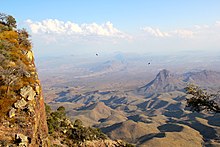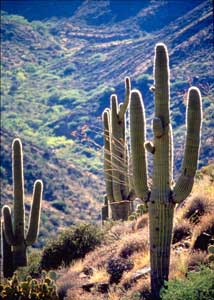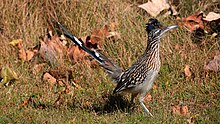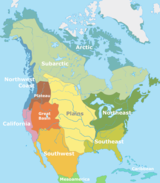Aridoamerica

Aridoamerica denotes an ecological region spanning Northern Mexico and the Southwestern United States, defined by the presence of the culturally significant staple foodstuff Phaseolus acutifolius, a drought-resistant bean.[1] Its dry, arid climate and geography stand in contrast to the verdant Mesoamerica of present-day central Mexico into Central America[2] to the south and east, and the higher, milder "island" of Oasisamerica to the north. Aridoamerica overlaps with both.[1]
Because of the relatively hard conditions, the pre-Columbian people in this region developed distinct cultures and subsistence farming patterns. The region has only 120 mm (4.7 in) to 160 mm (6.3 in) of annual precipitation. The sparse rainfall feeds seasonal creeks and waterholes.[3]
The term was introduced by American anthropologist
Mexican anthropologist Guillermo Bonfil Batalla notes that although the distinction between Aridoamerica and Mesoamerica is "useful for understanding the general history of precolonial Mexico," that the boundary between the two should not be conceptualized as "a barrier that separated two radically different worlds, but, rather, as a variable limit between climatic regions." The inhabitants of Aridoamerica lived on "an unstable and fluctuating frontier" and were in "constant relations with the civilizations to the south."[6]
Subsistence


The
Despite dry conditions, Aridoamerica boasts the greatest diversity of wild and domesticated
In Baja California, fishing and hunting provided food, as did harvesting acorns, nopal, pine nuts, and other native plants.[9]
Historically, people of Aridoamerica
Deserts

The elevation in the Chihuahuan Desert varies from 1970 to 5500 feet, as there are several smaller mountain ranges contained in the area, namely the San Andres, Doña Anas, and Franklin Mountains. The Chihuahuan is a "rain shadow" desert, formed between two mountain ranges (the Sierra Madre Occidental on the west and the Sierra Madre Oriental on the east) which block oceanic precipitation from reaching the area.[10] The Chihuahuan Desert is considered the "most biologically diverse desert in the Western Hemisphere and one of the most diverse in the world", and includes more species of cacti than any other desert in the world.[11] The most prolific plants in this region are agave, yucca and creosote bushes,[12] in addition to the ubiquitous presence of various cacti species.

When people think of the desert southwest, the landscape of the
The most northwest portion of Aridoamerica is covered by the
Wildlife

The region has an extremely diverse bird population, with hundreds of species being found in Aridoamerica. In the
Other bird species include the
Mammal species include the
There is a large contingent of snakes native to the region. Among them include: the
Other reptiles in the region include lizards and turtles. Lizards are highly represented in the region, the most distinctive denizen being the
Amphibians include numerous toads and frogs. Toads which can be found in the region include: the Great Plains toad (Anaxyrus cognatus); the green toad (Anaxyrus debilis); the Arizona toad (Anaxyrus microscaphus); the New Mexico spadefoot (Spea multiplicata stagnalis); and the Colorado River toad (Incilius alvarius), also known as the Sonoran Desert toad. Frog representation includes: western barking frog (Craugastor augusti); the canyon tree frog (Hyla arenicolor); the Arizona treefrog (Hyla wrightorum); the western chorus frog (Pseudacris triseriata); Chiricahua leopard frog (Lithobates chiricahuensis); and the relict leopard frog (Lithobates onca). There are quite a few salamanders throughout the region, including: the Arizona tiger salamander (Ambystoma mavortium nebulosum) and the painted ensatina (Ensatina eschscholtzii picta).[37]
Political geography
The current Mexican states that lie in Aridoamerica are:
The northern parts of:
- Hidalgo
- Guanajuato
- Querétaro
- Jalisco
The southern portions of the United States that lie within Aridoamerica are:
Aridoamerica cultures

- Acaxee
- Caxcane
- Cocopah), Baja California[9]
- Guachichil
- Guachimontone
- Guamare
- Guaycura, Baja California[9]
- Huarijio[38]
- Huichol[38]
- Kiliwa, Baja California[9]
- Kumeyaay), Baja California[9]
- Mayo[38]
- Mogollon culture, ca. 200–1500 CE, also Oasisamerica
- Monqui, Baja California
- Opata
- Otomi
- Pai Pai, Baja California[9]
- Pame
- Pericú), Baja California[9]
- Pima Bajo[38]
- Seri[38]
- Tarahumara[38]
- Tecuexe
- Tepecano
- Tepehuán[38]
- Teuchitlan tradition
- Western Mexico shaft tomb tradition
- Yaqui[38]
- Zacateco
See also
- Classification of indigenous peoples of the Americas
- Great Mural Rock Art, Baja California
- Mesoamerica
- Oasisamerica
Notes
- ^ a b c Pratt and Nabhan 419
- ^ Cordell and Fowler 85
- ^ a b Bye and Linares 273
- S2CID 23223873. Retrieved 3 July 2017.
- ^ Paul Kirchhoff, "Gatherers and farmers in the Greater Southwest: a problem in classification", in American Anthropologist, 56 (1954) (Special Southwest Issue), pp. 529–550, see map p. 544.
- ISBN 9780292708433.
- ^ Bye and Linares 256
- ^ a b Herr, Sara A. "The Latest Research on the Earliest Farmers." Archaeology Southwest Vol. 23, No. 1, Winter 2009, p.1
- ^ a b c d e f g h Schmal, John P. "Indigenous Baja". History of Mexico. Houston Institute for Culture. Retrieved 16 November 2015.
- ^ "The Chihuahuan Desert". New Mexico State University. Archived from the original on December 27, 2012. Retrieved July 6, 2015.
- ^ "Chihuahuan Desert". National Park Service. Retrieved July 6, 2015.
- ^ a b c "Deserts of Southwest USA". The American Southwest. Retrieved July 6, 2015.
- ^ a b c "Southern North America: Southwestern United States into northwestern Mexico". World Wildlife Fund. Retrieved July 6, 2015.
- ^ a b c Green, Kim & Don (October 1, 2001). "The American Southwest; Footsteps of the Ancients Expedition". Lonely Planet. Retrieved July 6, 2015.
- ^ "The Geologic Origin of the Sonoran Desert". Arizona-Sonora Desert Museum. Retrieved July 6, 2015.
- ^ "What & Where is the Mojave Desert?". Digital-Desert. Retrieved July 6, 2015.
- ^ "Mojave Desert". National Park Service. Retrieved July 6, 2015.
- ^ Sharp, Jay W. "Looking for Birds in the Southwest". DesertUSA. Retrieved July 13, 2015.
- ^ "Greater Roadrunner". Arizona-Sonora Desert Museum. Retrieved July 13, 2015.
- ^ "Hawks & Eagles". Arizona-Sonora Desert Museum. Retrieved July 13, 2015.
- ^ "Caracaras & Falcons". Arizona-Sonora Desert Museum. Retrieved July 13, 2015.
- ^ "Gray Hawk". Cornell Lab of Ornithology. Retrieved July 13, 2015.
- ^ "Owls". Arizona-Sonora Desert Museum. Retrieved July 13, 2015.
- ^ a b "Observations".
- ^ "Vultures". Arizona-Sonora Desert Museum. Retrieved July 13, 2015.
- ^ "Cardinals & Grosbeaks". Arizona-Sonora Desert Museum. Retrieved July 13, 2015.
- ^ "Finches". Arizona-Sonora Desert Museum. Retrieved July 13, 2015.
- ^ "Hummingbirds". Arizona-Sonora Desert Museum. Retrieved July 13, 2015.
- ^ "Quail". Arizona-Sonora Desert Museum. Retrieved July 13, 2015.
- ^ "Common Raven". Arizona-Sonora Desert Museum. Retrieved July 13, 2015.
- ^ "Woodpeckers". Arizona-Sonora Desert Museum. Retrieved July 13, 2015.
- ^ "Wrens". Arizona-Sonora Desert Museum. Retrieved July 13, 2015.
- ^ "Observations".
- ^ "Snakes of the American Southwest". Southwestern Center for Herpetological Research. Archived from the original on March 14, 2016. Retrieved July 13, 2015.
- ^ "Lizards of the American Southwest". Southwestern Center for Herpetological Research. Archived from the original on March 14, 2016. Retrieved July 13, 2015.
- ^ "Turtles of the American Southwest". Southwestern Center for Herpetological Research. Archived from the original on July 13, 2015. Retrieved July 13, 2015.
- ^ "Amphibians of the American Southwest". Southwestern Center for Herpetological Research. Archived from the original on March 14, 2016. Retrieved July 13, 2015.
- ^ a b c d e f g h i "Mexico: Map". Ethnologue. Retrieved 16 November 2015.
References
- ISBN 978-0-8263-4283-6. Retrieved 16 November 2015.
- Cordell, Linda S. and Don D. Fowler, eds. Southwest Archaeology in the Twentieth Century. Salt Lake City: University of Utah Press, 2005. ISBN 978-0-87480-825-4.
- ISBN 978-94-009-2786-5. Retrieved 16 November 2015.

